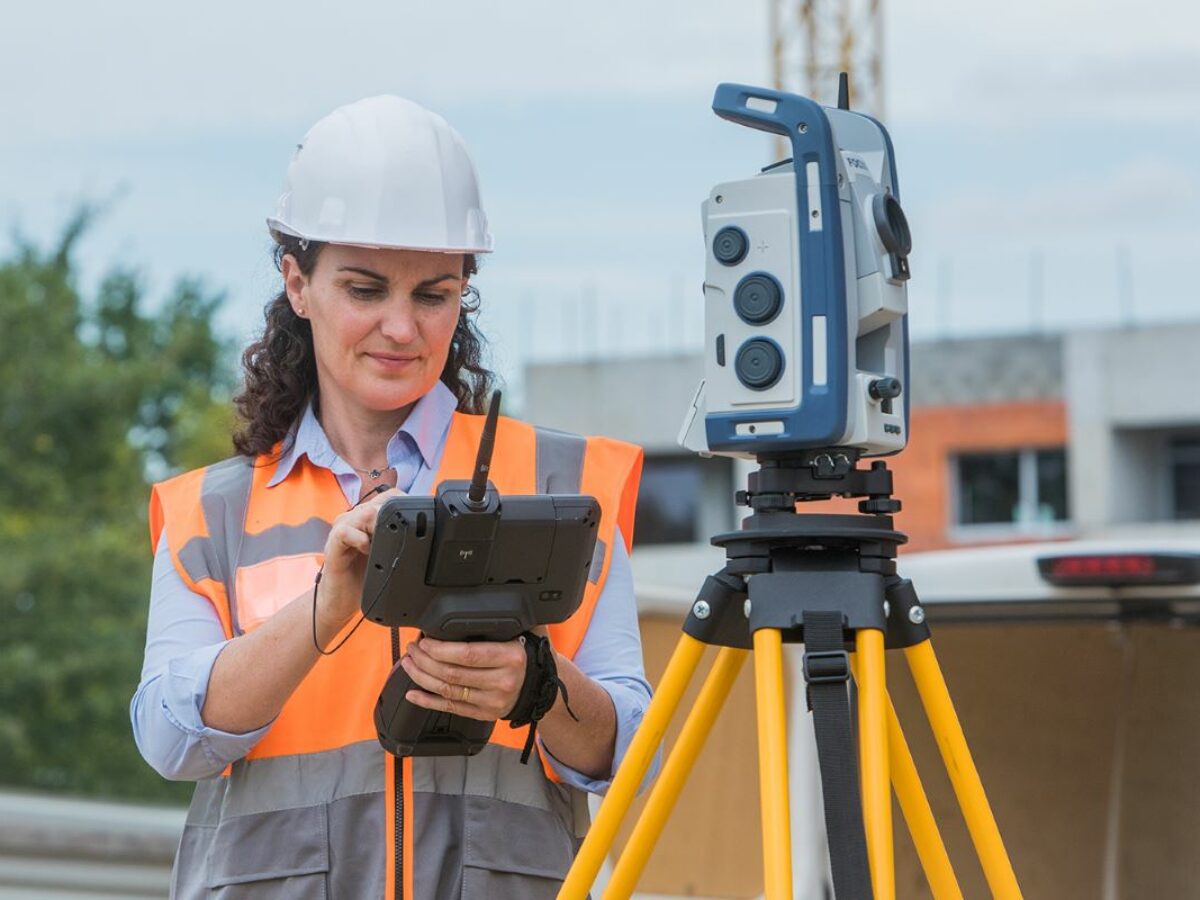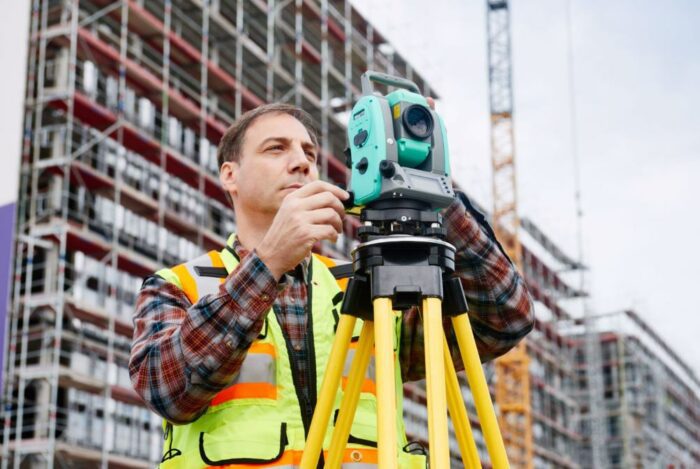Which Tool is the Best For Your Job
Mechanical and robotic total stations are both valuable tools used in surveying and construction projects. But they differ in terms of functionality and automation. Understanding the differences applied to the job at hand means you can invest in a total station that works for your specific project.
SEP offer a wide range of robotic and mechanical total stations, both new and reconditioned. We’re here to talk you through the differences, guiding you on the best surveying equipment for your application.
What’s the difference between Robotic and Mechanical Total Stations?
Mechanical total stations are traditional surveying instruments that require manual operation. They consist of a theodolite, which measures horizontal and vertical angles, and a distance meter, which measures distances to specific points. To use a mechanical total station, a surveyor must manually adjust the instrument’s position and take readings by looking through the eyepiece. This process can be
time-consuming and requires skilled personnel to operate the equipment effectively.
On the other hand, robotic total stations are advanced devices equipped with motorized systems and automation features. These stations combine the functions of a total station with a robotic mount and a remote control system. The robotic mount enables the instrument to automatically rotate and target specific points, while the remote control system allows the surveyor to operate the total station from a distance. This automation significantly increases efficiency and productivity by reducing the need for manual adjustments and constant monitoring by the surveyor.
What applications are robotic total stations best suited for?
Robotic total stations are well-suited for a wide range of applications in surveying, construction, and engineering projects. Here are some of the key areas where robotic total stations excel:
- Construction Layout: Robotic total stations are highly efficient for construction layout tasks. They can quickly and accurately determine the positions and alignments of critical points on a construction site, such as foundation corners, columns, walls, and other key reference points. The ability to remotely control the instrument and automate the targeting process significantly speeds up layout operations.
- Topographic Surveys: They are ideal for conducting topographic surveys, which involve mapping the contours, elevations, and features of a piece of land. They can be used to measure and record multiple points across a large area, capturing detailed data for creating accurate topographic maps.
- Road and Infrastructure Projects: Robotic total stations are commonly used in road and infrastructure construction projects. They can efficiently lay out road alignments, establish control points, measure cross-sections, and monitor the progress of earthwork operations. The ability to remotely control the instrument and set up multiple targets along the project site makes them particularly useful for large-scale road and infrastructure projects.
- Building Information Modeling (BIM): They play a crucial role in BIM workflows. They can be used to capture precise measurements and collect data for generating 3D models of existing structures or for verifying the accuracy of constructed elements against the BIM design. The automation features and high accuracy of robotic total stations contribute to the reliability of the collected data for BIM integration.
- Monitoring and Deformation Analysis: Robotic total stations are employed for monitoring purposes in applications such as structural deformation analysis, mining operations, and environmental monitoring. They can be set up for long-term monitoring of specific points, providing continuous data on movements, shifts, or changes in structures or natural environments.
Overall, the automation, accuracy, and remote control capabilities of robotic total stations make them indispensable tools for a wide range of applications, improving efficiency, productivity, and precision in surveying and construction projects.
What applications are mechanical total stations best suited for?
While robotic total stations offer advanced automation and remote control capabilities, mechanical total stations still have their place in certain applications. Here are some areas where mechanical total stations are well-suited:
- Small-Scale Surveys: Mechanical total stations can be a suitable choice for smaller surveying projects that don’t require extensive automation or remote control. These instruments are often more affordable compared to robotic total stations and can provide accurate measurements for smaller areas or localized surveys.
- Boundary Surveys: Mechanical total stations are commonly used for boundary surveys, where the focus is on establishing property lines and boundaries. These surveys typically involve measuring angles and distances between property corners or markers. The manual operation of these tools allows surveyors to precisely target specific points and ensure accurate boundary determinations.
- Training and Education: They are often used in training and educational settings to teach the fundamentals of surveying. Their manual operation requires students to develop essential skills in adjusting the instrument, taking readings, and interpreting survey data. This hands-on experience helps aspiring surveyors understand the principles and techniques involved in traditional surveying methods.
- Low-Tech Environments: In some environments with limited access to advanced technology or in areas where power supply and communication networks are unreliable, mechanical total stations can be more practical. These instruments don’t rely on motorized systems or complex electronic components, making them more robust and less dependent on external factors.
- Historical Preservation: When working on historical preservation projects, they can be preferred to maintain the authenticity and integrity of the surveying process. These instruments can be used to accurately measure and document historical structures or archaeological sites while respecting the traditional methods and techniques employed during the time of their construction.
It’s important to note that the choice between mechanical and robotic depends on the specific requirements of the project, the level of automation desired, budget considerations, and the expertise of the surveying team. Both types of this surveying equipment have their advantages and can be effective tools depending on the context and application at hand.
What are the specifications of robotic total stations?
Robotic total stations come in various models and configurations, each with its own specifications. Here are some common specifications you can expect to find in robotic total stations:
- Angular Accuracy: These specifications indicate the instrument’s ability to measure horizontal and vertical angles accurately. This accuracy is usually expressed in seconds or minutes of arc (e.g., ±1″ or ±3″).
- Distance Measurement Range: This specifies the maximum distance that the total station can accurately measure. It is typically several hundred meters or more. However, some advanced models may have longer-range capabilities.
- Distance Measurement Accuracy: This represents the instrument’s ability to measure distances precisely. Its often specified as a value in millimetres or a certain percentage of the measured distance. For example, an accuracy specification of ±(2mm + 2ppm) means the instrument can measure distances of 2 millimetres plus an additional 2 parts per million of the measured distance.
- Magnification and Minimum Reading: Robotic total stations have an optical system with a specific magnification that determines the level of detail visible through the eyepiece. The minimum reading specification indicates the smallest increment that can be read on the instrument’s scale.
- Tracking Speed: This refers to the maximum speed at which the robotic total station can automatically follow a moving prism or target. Higher tracking speeds allow for faster and more efficient data collection in dynamic surveying situations.
- Operating Range: The operating range specifies the maximum distance over which the robotic total station can establish a reliable wireless connection with the remote control unit. This range varies depending on environmental factors such as terrain, obstructions, and interference.
- Battery Life: Robotic total stations are powered by rechargeable batteries. The battery life specification indicates the duration the instrument can operate on a single charge. It is an essential consideration, especially for projects that involve long periods of continuous operation in the field.
- Environmental Specifications: Robotic total stations often come with specifications related to their resistance to dust, water, and extreme temperatures, typically expressed using IP (Ingress Protection) ratings.
It’s important to note that specifications can vary between different models and manufacturers.
What are the specifications of mechanical total stations?
As the functionality of mechanical total stations differs from their robotic counterpart, so does the specifications of the tool. Mechanical total stations also have angular accuracy, distance measurement range, distance measurement accuracy, magnification and minimum reading, battery life and environmental specifications. However, they also have:
- Operating Controls: Controls for adjusting the instrument’s position, focusing the telescope, and taking readings. The specifications may include details about the knobs, locks, and controls available for precise adjustments.
- Levelling Accuracy: Mechanical total stations often have built-in levelling mechanisms to ensure the instrument is set up correctly, further ensuring accurate measurements.
Here are some examples of the specifications of Trimble total stations.
| Model | Trimble S3 | Trimble S5 | Trimble S7 | Trimble S9 | Trimble SX10 |
| Angular Accuracy | 2 or 5″ | 1,2,3, or 5″ | 1,2,3, or 5″ | 0.5 or 1″ | 1″ |
| EDM Technology | DR Standard | DR Plus | DR Plus | DR Plus or HP | Lightning 3DM/td> |
| Range (Single Prism) | 2,500 m (8,202 ft) | 2,500 m (8,202 ft) | 2,500 m (8,202 ft) | 3,000 m (9,800 ft) | |
| Prism Tracking Type | Passive / MultiTrack* | Passive, MultiTrack, Active Track 360 | Passive, MultiTrack, Active Track 360 | Passive, MultiTrack, Active Track 360 | Advanced AutoLock |
| Additional Features | Tracklight | VISION | Long Range FineLock, VISION or Tracklight |
What types of robotic total stations does SEP supply?
From the “universal” Trimble SPS930 to the Spectra Geospatial Focus, SEP offers a selection of robotic total stations to suit different applications and budgets.
We also provide them as part of our used surveying equipment range. All of our reconditioned total stations are serviced and assured by our technical experts, to guarantee true value for money.
Alternatively, you can request to use our survey equipment hire service for short-term or long-term rentals.
What types of mechanical total stations does SEP supply?
Train your employees with the precision of the Nikon XF 2” total station. This smart tool is not only effective for surveying and construction industries, but also for the police, archaeologists, meteorologists and insurance companies.
We also provide them as part of our used surveying equipment range or you can request to use our survey equipment hire service for short-term or long-term rentals.
Other factors to consider
In comparison, robotic versions often come with advanced features such as tracking abilities, which enable the instrument to automatically follow a prism or reflector target, eliminating the need for constant repositioning. This makes them particularly useful for large-scale projects, where surveyors can set up multiple targets and remotely control the total station to collect data from various locations without physically moving the instrument.
Choosing the right tool for the job
While mechanical total stations rely on manual operation and require more time and effort from the surveyor, robotic total stations offer enhanced automation, remote control capabilities, and advanced features that significantly streamline the surveying process, increase productivity, and allow for greater accuracy and efficiency in data collection.
To truly choose the right tool for the job, you need to balance out the differences and decide on a tool that works best for the project at hand. Hopefully, these examples give you a better understanding of the different applications total stations can be used for. If you want to try before you buy or work on shorter-term projects, SEP offers survey equipment for hire. Allowing you to carry out surveying tasks with ease and without the full investment.

